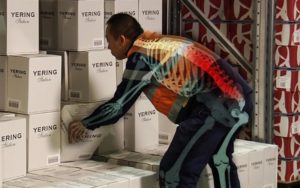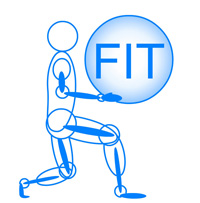Back Pain is NOT a Normal Condition!
I recently read an article that claimed that back pain is a normal human condition! Although it is true that 80% of the US population will suffer from back pain in their lives, it does not mean it is a “normal human condition.”
It would be like saying illiteracy in the 1800s was a “normal human condition.” Granted it was “normal” to be uneducated at the time, but to brand that condition a “normal human condition” would have been a major mischaracterization as in 2003 in many parts of the world the literacy rate was over 90% (99% in the US). (Max Roser and Esteban Ortiz-Ospina (2016) – ‘Literacy.’ Published online at OurWorldInData.org. Retrieved from: https://ourworldindata.org/literacy/)
Is it then possible to theorize that one can educate oneself on how to prevent back pain from ever occurring in the first place? Is our society functionally illiterate regarding the spine, one of the most important parts of our bodies?
Back Basics
 25 years ago FIT was established to prevent back and shoulder injuries (and since then, office ergonomic injuries too). Our first discovery was that most back injuries are caused by what we call CMT (cumulative micro trauma). CMT is an accumulation of tiny physical transgressions on our bodies that over time add up to fatigue, discomfort, pain and if continued, injury.
25 years ago FIT was established to prevent back and shoulder injuries (and since then, office ergonomic injuries too). Our first discovery was that most back injuries are caused by what we call CMT (cumulative micro trauma). CMT is an accumulation of tiny physical transgressions on our bodies that over time add up to fatigue, discomfort, pain and if continued, injury.
Secondly, we discovered shockingly, that as a culture we are virtually 100% illiterate as to the structure and practical function of our spines. This lack of understanding leads to a life of accumulating unnecessary CMT!
80% of the US population will experience back pain. A back injury can, in a brief moment, change one’s life or cause one to be on potentially addictive pain medication. Yet despite this horrific “natural human condition” no one has educated us (properly!) on how to perform normal activities of daily living in a way that would prevent CMT and its painful manifestations.
Proof!
How many cylinders do you have in your car? 4, 6 or 8? 70% of you or so will know that answer. How many bones (vertebrae) make up your spine? I will wait while you Google this, because, like me years ago, I had NO IDEA! Why are there curves in your spine? How many curves? We know more about our darn cars and trucks than we do our backs and we can replace our vehicles! Don’t feel bad, virtually 100% of us are functionally illiterate relating to our back and how to use it properly.
The spine is an engineering feat! You have to really work hard to “earn” a back injury. You have 24 bones: 7 cervical (neck), 12 thoracic (hump in your mid back); and 5 lumbar (base of spine)… and 3 curves.
After “practically educating” over one million employees about the very simple laws of lifting and living in a world with a 24/7 gravitational force, we can 100% pronounce that when people become educated why and on how to lift, bend, work, care for their children, mow the lawn, shovel snow, do laundry, work on a computer, in other words “live life,” injuries plummet.
We trained 20,000 flight attendants for an airline on how to do their work and life duties and how to properly stretch away CMT, and back and neck injuries dropped 63%!
SAMPLE TIP
Our Backsafe® on-site workshops experientially educate workers on how to NOT become a victim of back and shoulder pain. One of our Backsafe laws to prevent CMT is never reach for or with a load. Holding a box, baby, or bundle close to you significantly reduces “intradiscal” pressure on your spine. A 10 pound object held 10″ away from you becomes a virtual weight of 100 pounds on your spine.
Do this exercise: Stand up. Hold your arms out in front of you for a few seconds or until you feel a little fatigue. This is 12% of your body weight. Now relax your arms to a normal position and feel the relief. The relief you feel is your body thanking you for keeping your arms close to your body.
Now make believe you have a box or laundry basket in your hands and you want to set it down on a desk or table. Move close to the table whereby you can set the “load” down without reaching. How pathetically simple Yet, extremely beneficial to know and apply to your life.
FIT wants to increase employees’ physical literacy as pertains to musculoskeletal well-being. The beautiful part about our process is no matter an organization’s morale, employees are eager to know how to relieve pain and discomfort and willingly buy-in to change their behaviors on and off the job.
Email us at info@backsafe.com or call us at (800) 775-2225 and schedule an interview to learn how we can help your employees and help your company to prevent painful injuries and to save money in 2017.
Prevent tomorrow’s injuries today!™
Dennis Downing, President
Future Industrial Technologies
*This article may be reprinted in its entirety provided that the following resource is left intact:
Future Industrial Technologies, Inc. (F.I.T.) offers workplace safety and ergonomics training programs. Backsafe® teaches employees how to perform their specific job tasks in a manner that is biomechanically correct. Sittingsafe® teaches office employees how to adapt their existing workstations so they are ergonomically correct. These injury prevention programs make your workplace safer and are proven to reduce injuries and worker compensation insurance costs.
For more information contact Dennis Downing at:
Future Industrial Technologies, Inc.
5951 Encina Road, Suite 201 | Goleta, CA 93117
Tel (800) 775-2225 | Fax (805) 967-2487
Email: info@backsafe.com | Website: https://www.backsafe.com

Recent Comments